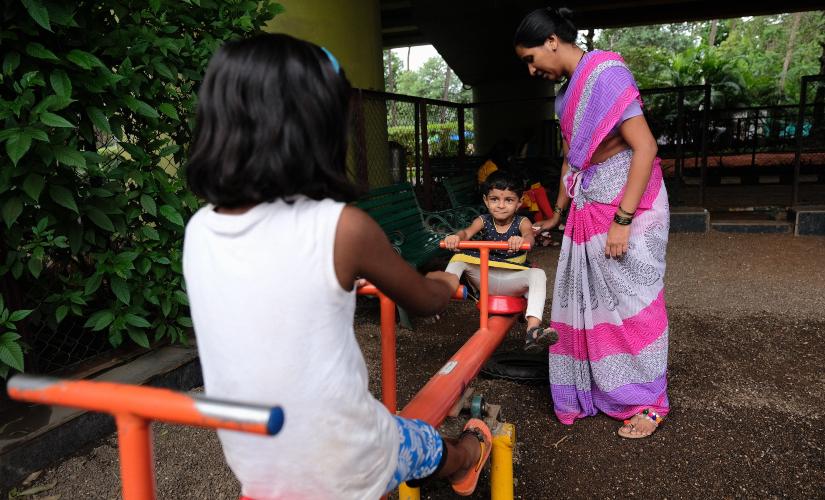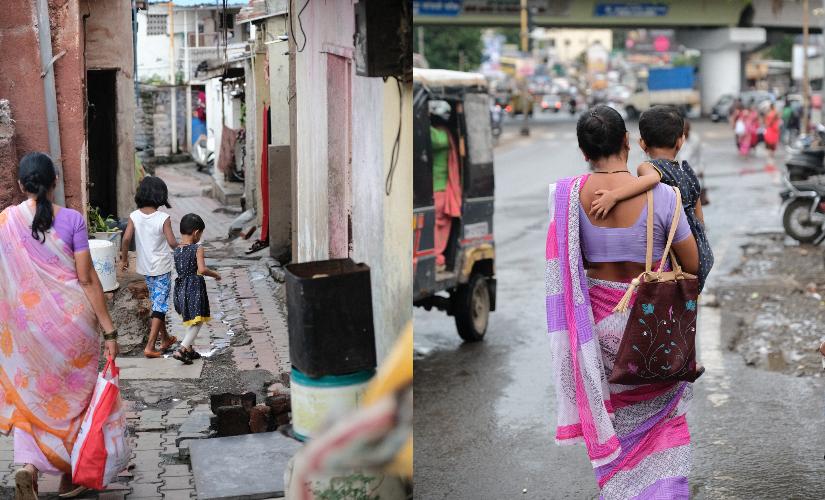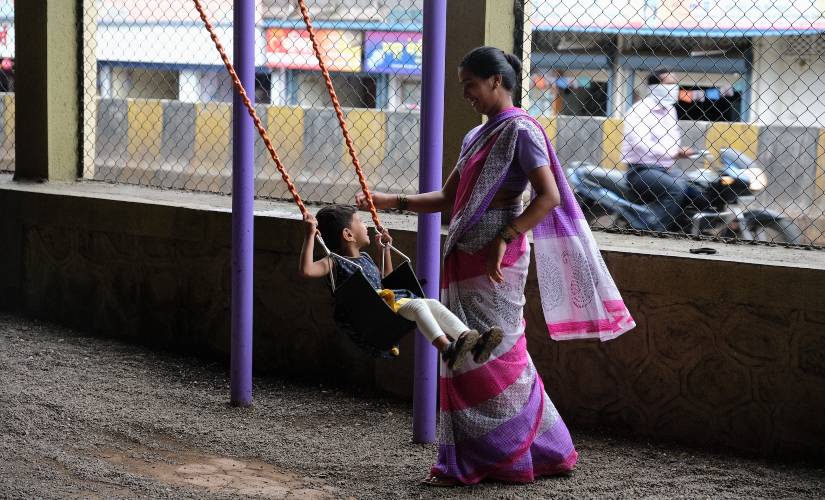Play for children, as Jawaharlal Nehru saw it, was a vital unifying force when the new republic came into existence. Nehru believed that as children play, “(T)hey do not think of differences amongst themselves, difference of class or caste or color or status,’’ he said. “They are wiser than their fathers or mothers.” But more than 70 years after independence, India fails to provide the bare minimum to its children. As surveys by the government show, 40 percent of schools do not have a playground. In states like Bihar and Odisha, this number can rise as high as 65 percent and 70 percent respectively. This deficiency is having a detrimental effect on the health of children. A survey of 85 cities across India revealed that 40 percent of children do not have a healthy Body Mass Index (BMI). And crucially, health indicators of children in bigger metros — New Delhi, Mumbai, Kolkata, Bengaluru, Chennai, and Pune — are significantly worse than those from smaller towns and rural areas. [caption id=“attachment_7642041” align=“alignnone” width=“825”]  Photograph by Shamsheer Yousaf[/caption] As the density of children in cities has been increasing (see this UNICEF report), most childhoods are now experienced in urban environments.
In particular, children from disadvantaged areas like slums are the most vulnerable.
They live in unsafe and unhealthy environments, with minimal access to services — from play options, to nearby schools. *** On a June afternoon in the eastern suburbs of Pune, under the gaze of the Sahyadri hills and the pregnant monsoon clouds, a three-year-old girl is creating a ruckus in her home. It’s playtime. Affectionately called Chinki, she is ordering around her mother and another girl (a neighbour) in their house in Ramnagar slum (Warje). They are in a small room, about four meters by three meters, where Chinki spends most of her time — sleeping, eating, and most importantly, playing. Jyothi Shankar, Chinki’s mother, is worried about her being penned up in the room all day. “There is no space outside the house,” she says. As in most slums, the residents live cheek by jowl, and the alleys are so narrow that two adults can barely pass by. [caption id=“attachment_7642011” align=“alignnone” width=“825”]  (Left) The children making their way to the park using a short-cut through the neighbourhood (Right) The route to the park. Photographs by Shamsheer Yousaf[/caption] Construction work next to Jyothi’s house makes it precarious, and even dangerous, for children to play outside. And then there is the fear of violence — gangs of young boys from the slum are often roaming around, and children can get caught in the crossfire. Hygiene is another issue — the alleys are teeming with garbage. “When the sewage line gets blocked, it flows on the street outside. We live at the bottom of the hill as you can see,” says Jyothi. Every time the municipal corporation cleans the drains, they dump the waste in front of her house. And then there are other factors — spit stains from chewing tobacco, defecation by cats and dogs, and the carcasses of rats hunted down by crows in the slum. “Chinki sees all this and is frightened to step outside,” says Jyothi. Dedicated playing spaces for Chinki are few and far between. A nearby park with jogging tracks— about a five-minute walk — does not have any play facilities for children. *** Chinki’s experiences are consistent with what a recent report on Shaping Urbanisation for Children found. It found that children in disadvantaged/slum areas are subject to a wide range of vulnerabilities. Some of these include the quality of the built environment, unavailability of municipal services, pollution, reduced physical activity, etc. These vulnerabilities — as the report rightly points out — are due to the narrow definition of ‘access to basic services’. Though the provision of spaces to play and access to these points are deemed necessary within policy and literature, reality paints a different picture. [caption id=“attachment_7642021” align=“alignnone” width=“825”]  The route to the park cuts across a private open field. Photograph by Shamsheer Yousaf[/caption] Urban environments also need to satisfy the requirements of a range of caregivers — mothers, fathers, grandparents, aunts, uncles, and siblings. Shared spaces need to be multi-layered and multi-dimensional. Streets need to function not only as play spaces, but also as extensions of their home, a place for communal gathering, to conduct trade, and to celebrate festivals. Earlier this year, we conducted a workshop with 15 caregivers — mothers, grandmothers, and aunts — in an anganwadi at Ramnagar slum to understand how they looked at play spaces. The challenges they brought forward were multifaceted. Though most prefer that children play where they can be observed, they play where they can, often unobserved. It quickly became apparent that play was happening not only in places such as parks (at best a weekly affair), but rather in temple grounds, in front of homes, empty lots, gallis, and inside the house.
Most caregivers told us that they wished for safe places for their children to play at near their house rather than the single park, a 20-minute walk away.
But there are several deterrents: poor road maintenance, garbage, absence of street lights, flooding in lower parts of the settlement, street dogs that have the run of the large open maidan in the area, harassment of girls on the streets, drinking in public spaces, among others. Ideally, caregivers wanted clean and safe places where children have access to play equipment (swings, slides). But the reality is that the supply of these types of designated play spaces is limited. If play can be understood as an activity that can happen anywhere, as it is now, rather than in designated play spaces, the priority of creating safer streets can take precedence over buying play equipment. *** The only actual play space that Jyothi and Chinki have access to is the Barate Park, maintained by the Pune Corporation, which has ample play facilities. It is open between 4 pm and 8 pm. But Jyothi can’t make it regularly to the park, as she needs to wait for the water supply around this time. Though the park is not too far on paper — about 1.5 kilometres — the journey can be quite arduous. For one, there is no affordable public transport that they can avail. Traffic and the lack of footpaths can extend the trip to 45 minutes one-way. On this June evening, when Jyothi decides to visit Barate Park, the challenge is in getting there. The terrain at several places can be steep, but Jyothi takes a shortcut through a maidan, with garbage strewn all across. She points to a group of men sitting together and whispers, “This is where the men from the colony (neighbourhood) come to drink.” Chinki finds it challenging to walk through the mud following the monsoon rain. And so, Jyothi carries her in her arms across the ground. [caption id=“attachment_7642071” align=“alignnone” width=“825”]  The park under the fly-over. Photograph by Shamsheer Yousaf[/caption] Soon they hit the road, but the traffic makes it dangerous for Jyothi to let Chinki walk. So she continues carrying her. The chaos and noise from the traffic follows them. Typically, air pollution compounds this further, but on this evening, the afternoon showers have cleared the air. Soon the Barate Park — officially the Late Pruthak Barate Garden — comes to view. By utilising the space under a flyover, typically used for parking or by street vendors, the Pune Municipal Corporation has built a modest-sized park of around 3,500 sq metres. The park is very popular with the residents of Warje who walk along the track around the park, attend communal yoga classes, and bring their children to the play area. However, before they can enter the park, Jyothi needs to cross a highway to get to it. Traffic, including buses and trucks, are coming at them from all sides — with most drivers ignoring traffic signals. It takes a few minutes before Jyothi successfully crosses the junction. *** Upon entering the park, Chinki’s demeanour brightens. The play area is divided into two sections; they enter the one on the left. Chinki and her companion spring for the slide. The two take turns at it. Jyothi helps push Chinki higher at her turn. The two then head to the seesaw. For a while, Chinki forgets about her mother, allowing Jyothi to watch her from the bench. Chinki slips and falls. She turns to Jyothi, who immediately looks away, pretending to have not noticed. Chinki wipes her knee, and resumes play. A little later, she and her companion ride the duck carousel as Jyothi and another parent propel them around. [caption id=“attachment_7642051” align=“alignnone” width=“825”]  Chinki the happiest she has been in the last few hours. Photograph by Shamsheer Yousaf[/caption] The park is not big enough to mask the noise from the traffic, nor the pollution from the vehicles around. But for Chinki, this is as good as it gets. Throughout the stay at the park, she has been beaming. *** Some initiatives, such as the Child-Friendly City Initiative, have been around since the late 90s, with many cities setting the agenda to become a Child-Friendly City. The National Institute of Urban Affairs (NIUA) in New Delhi has been developing Child-Friendly Smart Cities (CFSC) in India within the national urban agenda of building smart cities. They have been promoting priority areas such as health, safety, mobility and living conditions. While the recognition and increasing awareness of children’s agenda within cities are positive, pressure from commercial interests and the government itself can undo much of this progress. For instance, in Delhi, the High Court had to intervene in 2018 to stop the construction of a multi-level parking facility over a playground. In Mumbai, the traffic department wanted to take over 22 maidans to develop pay-and-park facilities. In Bengaluru, encroachment over parks has become so severe that, at one point, the Department of Youth Services refused to provide equipment to playgrounds until the city corporation ’located’ all 256 grounds on paper. For families with children in slums areas, where almost 300 million children grow up, the urgency of responding to their vulnerabilities and well-being is pressing. We must provide for slum children, one of the most disadvantaged demographics in urban areas, often without a voice. Sukanya Krishnamurthy teaches Urban Geography at the University of Edinburgh. Shamsheer Yousaf is a Bengaluru-based journalist writing on development issues. The Bernard van Leer Foundation funded the research for this project.


)

)
)
)
)
)
)
)
)



